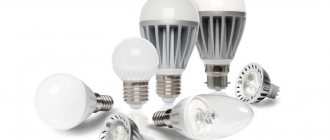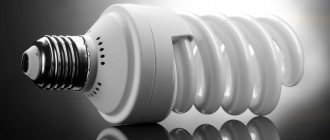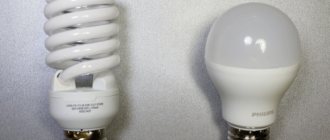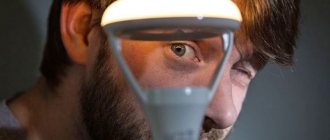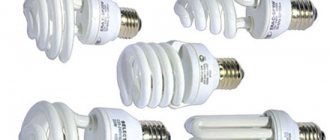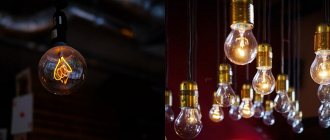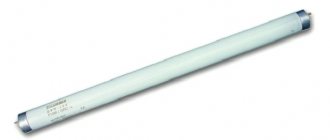LEDs have become a very popular light source in the last decade. They came to replace compact fluorescent lamps (CFLs) or, as they are popularly called, energy-saving lamps. Then the era of LED lighting for humans began.
Energy-saving lamps were relatively dangerous due to the mercury vapor contained in their bulb. If it is destroyed, there is a risk of serious harm to your health, even death. Let’s look at whether LED lamps are harmful to humans?
Sources of harm to health
To prove or disprove the harm of LED lamps to health, we will determine the sources of damage to the body. Let us conditionally divide them into 2 groups: device characteristics and improper operation.
Characteristics of a lighting device that are harmful to the body:
- Spectral characteristics of the light source;
- radiation in the infrared spectrum;
- pulsations of light flux.
The second group is harm to health not from the light source itself, but from its improper use. Let's look at each lighting factor that affects your health and determine whether LED light is harmful to your eyes.
LED lamp device
The LED lamp includes a hemispherical diffuser, chip-based LEDs, a thermally conductive printed circuit board, a driver for uninterrupted operation, a polymer base that serves as protection against flashover, and a nickel-plated brass base that creates a connection to the socket
Appearance of a modern LED lamp
White LEDs are most often used for lighting. There are suggestions that light bulbs will soon be replaced by similar LED lighting. So in recent years, increased demand has increased supply, light output has increased by 1.5 times, and the price has dropped three times. Our industry has started producing LED lamps using the latest technology. Outwardly, they are not much different from the traditional “Ilyich light bulbs,” but the principle of operation is completely different.
What are the differences between light sources?
Sunlight should be taken as the standard, since it contains the most complete spectrum of light radiation. Of all the artificial lighting devices, the incandescent light bulb is the closest to the sun. Compare the spectral characteristics of different sources.
The graphs show different spectra of lighting fixtures. Incandescent light has a smooth spectrum, increasing towards the red region. The spectrum of fluorescent light sources is quite ragged, plus a low color rendering index (about 70).
Working in rooms with such lighting causes increased fatigue and headaches, as well as distorted color perception.
The spectrum of LED lamps is more complete and even. It has increased intensity in the wavelength region of 450 nm, for cold glow, and in the region of 600 nm, for “warm” lamps, respectively. LED sources provide normal color rendering with a CRI index of more than 80. LED lamps have extremely low ultraviolet radiation intensity .
If you compare the spectrum of diode and popular fluorescent lamps, it becomes clear why the latter are used less and less. The spectrum of CFLs is completely far from the standard, and their color rendering index leaves much to be desired.
Based on this, we can conclude that, based on the characteristics of the spectrum, LED lamps are harmless to health.
New "safe" LED technology
But in the same year, the Nobel Prize in Physics was awarded to a group of Japanese scientists who discovered a new technology that makes it possible to produce white LED lamps, the harm from which is minimal. The light source is a combination of several multi-colored diodes, the radiation of which is mixed under the influence of a special lens, resulting in white light, which is similar to the natural process of forming “colorless” natural light.
There are currently three technologies for creating white LED lamps:
- Phosphor LEDs (blue or ultraviolet radiation is passed through a layer of phosphor, which is most often phosphorus) are the “oldest”, cheapest and most dangerous type.
- RGB LEDs (multi-channel), invented in 2014. Various numbers of base colors can be used to produce light.
- Hybrid LEDs combine both technologies.
Thus, we can conclude that the less “cold” and long-wave radiation an LED lamp produces, the safer it is for vision.
However, light radiation that directly damages the retina is not the only danger to human health that lighting devices of this type can pose.
Why do the lamps flicker?
The next factor that affects well-being is the pulsation coefficient of the light flux. To understand what it is and what it depends on, you need to consider the shape of the voltage in the electrical network.
The quality of light and its pulsation depend on the power source from which they operate. Light sources that operate on constant voltage, such as 12-volt LED lamps, do not flicker. Let's look at flickering and the harm of LED lamps to the eyes, the causes of their occurrence and ways to eliminate them.
From the outlet we receive alternating voltage with an effective value of 220V and 310V amplitude, which you can see in the top graph (a).
Since LEDs are powered by direct current, not alternating current, it needs to be rectified. The body of the LED lamp contains an electronic circuit with a single- or full-wave rectifier, after which the voltage becomes unipolar. It is constant in sign, but not in magnitude, i.e. pulsating from 0 to 310 volts, graph in the middle (b).
Such lamps pulsate at a frequency of 100 hertz or 100 times per second, in time with the voltage ripples. The harm to the eyes of LED lamps depends on their quality, more on this later.
Do the LEDs pulsate?
LED lamps use drivers with current stabilization (expensive), or anti-aliasing filters (cheap). The voltage becomes constant and stabilized if capacitive filters are used.
If the manufacturer has not saved on the driver, the current value becomes stable. This is the best option for both ripple reduction and LED lifespan.
The photo below shows what the pulsations look like from the camera's perspective. You may not notice the pulsation, since the organs of vision strive to adapt the picture for perception. The brain absorbs these pulsations perfectly, which causes fatigue and other side effects.
The effect of LED lamps on human vision can be negative if they produce a pulsating light flux. Sanitary standards limit the depth of pulsations for office premises to 20%, and for places where work is carried out causing eye strain to 15%.
Lamps with large pulsations should not be installed at home; they are only suitable for lighting the corridor, pantry, entrances and utility rooms. Any room where you do not do any visual work and do not stay for a long time.
The harm from low-price LED lamps is caused primarily by pulsations. Don’t skimp on lighting; an LED with a normal driver costs only 50-100 rubles more than the cheapest Chinese analogues.
Other light sources and their pulsations
Incandescent lamps do not flicker because they operate on alternating current and the filament does not have time to cool down when the voltage crosses the zero mark. Fluorescent tubular lamps flicker if connected using the old “throttle” circuit. You can distinguish it by the characteristic throttle hum during operation. The photo below shows the pulsations of a raster lamp as seen by the phone camera.
More modern CFLs and LLs do not hum or flicker only because their circuit uses a high-frequency switching power supply. Such a power source is called an electronic ballast (electronic ballast or device) .
Presence of harmful elements
As mentioned above, LED lamps do not contain hazardous mercury, but in 2010, the scientific journal Environmental Science and Technology published data indicating the presence of other highly hazardous substances in some LED lighting devices. This time, the danger was discovered in red LEDs, which are often used in a variety of technical devices, from New Year's garlands to car headlights.
A team of scientists from the University of California, led by Professor Oladele Ogunseitan, found significant concentrations of arsenic, lead and several other hazardous substances in such lighting devices. In addition to being known neurotoxins, with prolonged exposure to the body, these components can provoke the formation of malignant tumors.
It was also discovered that some manufacturers use nickel when creating modern white LED lamps, which can cause a severe allergic reaction. And against this background, copper looks the “safest”, which, although it does not cause direct harm to the human body, can nevertheless provoke a local environmental disaster if such devices are disposed of near rivers or lakes.
Of course, the concentration of these substances in one lamp is not dangerous for humans, but 10,50,100 broken “dirty” LEDs will most likely lead to toxic poisoning. This problem is especially relevant for road workers, who often have to remove broken headlights or street/road lighting lamps.
It is worth noting that in most cases such “additives” are necessary only to reduce the cost of the production process. Therefore, with proper legislative regulation, it is quite possible to combat this negative trend by making economical LED lighting much safer.
LED technology is a truly important technological breakthrough. And, like any new discovery, it can, along with obvious advantages, conceal hidden threats. But based on existing data, we can conclude that the safety of LED devices largely depends on the manufacturer, and a high-quality LED lamp is not much more dangerous than a traditional incandescent lamp.
Harm from the infrared spectrum
To determine whether LED lamps are harmful to vision, consider the third factor of harm - infrared radiation. It is worth noting that:
- Firstly, the harmfulness of the IR spectrum is doubtful and does not have a solid argument;
- secondly, in the spectrum of LEDs, infrared radiation is either absent or extremely small. You can verify this in the graphs given at the beginning of the article.
Are halogen lamps harmful to health? In light sources rich in the infrared spectrum (halogens), responsible manufacturers (Philips, Osram, etc.) use IR filters, so their harm to health is minimized.
Difference from conventional lamps
These models of LED table lamps combine the advantages of various light sources that conventional lamps do not have:
- high color rendering index CRI>95, like incandescent lamps;
- low energy consumption 8-10W, like fluorescent light bulbs;
- smooth change in color temperature, from incandescent to fluorescent;
- compact dimensions, like LED lighting sources;
- The design is combined with the versatility of the structure.
Blue spectrum harm
It has been scientifically proven that radiation in the blue spectrum reduces the production of the sleep hormone melatonin and damages the retina, causing irreversible changes in it.
In addition to a drop in melatonin levels, blue light radiation causes a number of side effects: fatigue, increased eyestrain, eye disease. This color is perceived as brighter, which is often used in marketing to attract our attention. Most indicators on speakers, TVs, monitors, and other equipment are blue.
More details about this and how safe LED lamps are for the eyes are written in the community.
White LEDs are blue LEDs coated with a special phosphor that converts the radiation to white.
Blue color is the most negative factor in the influence of LED lamps on vision. Take a look at the graphs, namely the emission spectrum of the LEDs presented above. Even a warm-light LED lamp has a brightness peak in the blue spectrum, while a cold lamp has a very high brightness peak.
The practical side of the problem
So the harm of LED lamps to humans is not a myth? Not certainly in that way. The fact is that the studies were carried out under conditions where the samples under study were illuminated with powerful blue LEDs and their entire spectrum was in the “harmful” range.
Although there is a share of blue light in cold LEDs, it is no less in sunlight.
Modern people of any age spend a lot of time in front of computer screens, smartphones and tablets. Continuous focusing at a distance of 0.3-1 meter from the screen causes incomparably greater damage to vision.
The harmfulness of the blue spectrum of LED lamps, compared to the harm from device screens, is insignificant. LED is ideal for illuminating a room, office or other premises with a stream of bright light with low energy consumption.
If you are worried, various types of lenses and glasses for computer work have been developed to reduce the harm of blue radiation. Their filters reflect light in the blue range and make colors warmer.
You need to remember : it is not LEDs that are harmful to human health, but the incorrect mode of working with gadgets and poor lighting.
Harmful lighting and GOST
But as for the light itself from the light bulbs, as they say, there are nuances. First of all, this relates to the spectrum.
Not all spectra are equally useful.
The most harmful of them are blue and purple.
As the American proverb says, “Blue Light has a Dark side.”
The safe spectrum is green and red.
It is not for nothing that the red sun at dawn and sunset is considered very pleasant and beneficial for health. And yogis prefer to meditate at this time of day.
All degrees of harmfulness and risk of artificial lighting have long been calculated and described in GOSTs. Here is an excerpt from GOST R IEC 62471-2013 ().
The most dangerous are light bulbs with blue spectrum LEDs from 15W and above (3rd risk group).
Even most LED lamps for household use can easily be classified into the second group. This is explained by the fact that white LEDs also contain a blue component.
And only the good old incandescent light bulbs are deservedly considered the safest (zero and first categories).
LEDs - benefit or harm?
You can understand whether LED lamps are harmful or not by organizing proper lighting in accordance with GOST on lighting. It regulates the amount of light to carry out work of varying precision and size of parts that you operate with during work.
LED light sources allow you to achieve the desired brightness in the workplace, with minimal electricity bills. You will preserve your vision, it will be easier for you to work when the room is light and you don’t need to look at small details in dim light. In this case, the harmfulness of LED lamps to the eyes is minimal.
The high energy consumption of old incandescent lamps is unprofitable both on a national scale (high load on power lines) and on an individual scale (high consumption and high price of electricity).
Today, the debate about whether LED lamps are harmful to vision remains open and a definite answer cannot be given. They have filled the lighting market relatively recently, less than 10 years ago, and many are skeptical about them.
The impact of LED lamps on human health will be zero if the daily routine, sleep and work are followed correctly. If a person is subject to stress, excessive loads and does not take the quality of sleep seriously, no light source will preserve his health.
If you have personal experience, a link to an interesting source, or you want to talk about the dangers of diode lamps, share in the comments.
Impact on the body
The blue peak around 450 nm from LEDs affects the entire body in addition to the retina. This happens through suppression of melatonin production.
Instead of rest and sleep, on the contrary, we want movement and action.
What is melatonin and why is it needed? This is a hormone that directly affects metabolic processes.
It is produced in the endocrine gland. Suppression of melatonin leads to early cellular aging.
Melatonin is an antioxidant that protects our mitochondria and DNA from damage, an assistant to the immune system, enhancing its function.
However, not everything here is so simple and it’s still not worth blaming the LEDs. As deeper research has shown, the dependence is primarily expressed in color temperature.
The higher it is, the more melatonin synthesis is suppressed. Moreover, this process occurs equally under different lighting sources.
That is, there is not much difference between LEDs and other types of light sources. Any artificial lamps with a temperature of 6000-6500K have an equally bad effect on melatonin production.
How to protect yourself from this?
1Never use cold blue light lamps in the bedroom.
It is better to leave incandescent light bulbs there, or install alternative night lights.
2Before going to bed, protect yourself from bright sources of light.
Don't sit in front of a computer monitor or smartphone screen.
3As night lights, it is better to use lamps with a red tint rather than a purple one.
4Do not use obscure Chinese products with untested characteristics.
The benefits of LED in everyday life
In addition to household applications, you can save on artificial greenhouse lighting. The range of LEDs for phytolamps allows your crops to grow faster and better. For this purpose, HPS lamps are often used, the light of which contains different wavelengths.
The power of such light sources is calculated at hundreds of watts, while LED phytolamps have a power ten times less and contain only the necessary wavelengths for better plant growth.
Although prices have decreased by about 10 times from 2011 to 2022, the price of one LED lamp equivalent to 100 W incandescent remains at the level of 10 incandescent lamps, which stops many consumers from making a purchase.
For the environment, abandoning gas-discharge lamps is an absolute plus; we wrote about this in an article about waste of LED products. But what danger LED lamps pose to health is not yet fully known. What is clear is that there is no longer any fear of mercury vapor.
The use of new light sources by a wide range of people allows developers to receive finance for new, more advanced projects. And technological progress is always moving forward. Therefore, we need to wait for statistics, then it will become clear how much harm LED lamps cause to health, and this takes time.
Please rate the article. We tried our best:)
Did you like the article? Tell us about her! You will help us a lot :)
“Classic” white LED lamps
LEDs became commercially available only in 1962. But mass production of home lighting devices using this technology began only in 1993, when a method for creating white LEDs was discovered. It consisted of passing light from a blue LED element (based on indium and gallium compounds) through a layer of phosphor.
It was the potential harm from LED light sources of this type that caused the greatest concern among experts. The fact is that a blue LED generates electromagnetic waves with a length of 460–500 nm, which is critically close to the parameters of dangerous ultraviolet radiation. The experiments of the Spanish University Complutense caused the greatest resonance. For their experiments, university specialists took samples of the retina of healthy people and grew artificial tissue from them. Then the “artificial eyes” were exposed to light irradiation with different properties, as a result of which it was found that white LED lamps are most harmful to health: direct short-term (up to 100 seconds) irradiation destroys a large number of retinal cells and seriously inhibits their regeneration.
In 2014, a group of scientists also tried to answer the question “are white LED lamps harmful to human health” and conducted similar studies, which, however, were closer to real conditions. The experiment involved a group of laboratory rats who lived for some time in a cage with a lamp suspended at such a height as to simulate overhead artificial lighting in an ordinary apartment. After 9 days of such irradiation, pathological changes in the retina of the eye were discovered in rats, caused by the death of nerve cells and a slowdown in the process of their regeneration. In this experiment, various light sources were also used, the result of which was confirmation of the previous theory: the increase in the wavelength of light radiation is directly proportional to the rate of degenerative processes in the retinal tissue.
Results
The tested models provide the best illumination compared to other light sources, which is similar in spectrum to natural sunlight.
LED lamps Flora and Orion with a high color rendering index CRI can serve as a good gift for schoolchildren and the elderly. The sooner you start taking care of your vision, the longer you will preserve it. Author: Sergey Kazantsev Samples tested in the laboratory, official website led-obzor.ru I test LED lamps for the home, LED strips, lamps, spotlights. Car bulbs, halogen and xenon, fog lights, daytime running lights.
Ripple factor
In ordinary lamps, when the brightness changes, pulsations appear with a frequency of 100 Hertz. They are invisible to the eye and quite harmful, deteriorating well-being, performance, headaches, and fatigue. I felt all these symptoms while working in an office with cheap lighting.
Measurements show that there is no ripple when the brightness changes. This is a good result and is rare in lamps.
Colorful temperature
One of the advantages of Orion and Flora LED table lamps is the ability to smoothly adjust the color temperature. When turned on, it shines with neutral white light 4300K, the shade smoothly changes with two touch buttons. The measured adjustment range was from 2700K to 6700K, which corresponds to warm and cool white light. This will allow you to create comfortable lighting for your workplace depending on your preferences.

